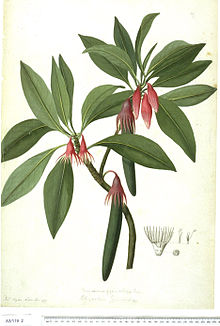This article relies largely or entirely on a single source. (July 2016) |
| Bruguiera | |
|---|---|

| |
| Bruguiera gymnorrhiza | |
| Scientific classification | |
| Kingdom: | Plantae |
| Clade: | Tracheophytes |
| Clade: | Angiosperms |
| Clade: | Eudicots |
| Clade: | Rosids |
| Order: | Malpighiales |
| Family: | Rhizophoraceae |
| Genus: | Bruguiera Lam. |
Bruguiera is a plant genus in the family Rhizophoraceae. It is a small genus of five mangrove species and three hybrids of the Indian and west Pacific Ocean region, its range extending from East Africa and Madagascar through coastal India, Sri Lanka and Southeast Asia to northern Australia, Melanesia and Polynesia.[1] It is characterised by calyces with 8-16 lanceolate, pointed lobes, 16-32 stamens, explosive release of pollen, and viviparous propagules. It is named in honour of French explorer and biologist Jean Guillaume Bruguière (1750–1798). Recently, the eighth taxa of Bruguiera, B. × dungarra (a previously undescribed hybrid species between B. exaristata and B. gymnorhiza) was recognised as occurring in northern Australia.[2][3][1]
- ^ a b "Bruguiera Lam." Plants of the World Online. Royal Botanic Gardens, Kew. Retrieved 16 November 2020.
- ^ Duke, N. C. (2017), "Mangrove Floristics and Biogeography Revisited: Further Deductions from Biodiversity Hot Spots, Ancestral Discontinuities, and Common Evolutionary Processes", Mangrove Ecosystems: A Global Biogeographic Perspective, Cham: Springer International Publishing, pp. 17–53, doi:10.1007/978-3-319-62206-4_2, ISBN 978-3-319-62204-0, retrieved 2020-11-15
- ^ Duke, N.C.; Kudo, H. (2018). "Bruguiera × dungarra, a new hybrid between mangrove species B. exaristata and B. gymnorhiza (Rhizophoraceae) recently discovered in north-east Australia". Blumea - Biodiversity, Evolution and Biogeography of Plants. doi:10.3767/blumea.2018.63.03.03. ISSN 0006-5196.